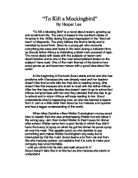There is an obvious racial division in the town of Maycomb. Blacks are seen as inferior and many work in houses, as cooks and cleaners. There is a history of slavery that dates back to Simon Finch, who ‘having forgotten his teacher’s dictum on the possession of human chattels, bought three slaves.’ Scout’s cook, Calpurnia, is a black woman who is able to read and write and considered being, ‘more educated than most black folk.’ This shows that blacks had less of a chance in life and were not treated with equality.
‘The Radleys, welcome anywhere in town, kept to themselves, a predilection unforgivable in Maycomb.’ The children show a morbid interest in the mysterious occupant of the Radley place. They are inspired by childish curiosity. Part of the adult population shows the same morbid interest. They are inspired by bigotry. Maycomb society discriminates against the Radleys because they don’t socialise with the community and behave differently and so are considered social outcasts. It is an ignorant society, that don’t except anything that is different to the ‘normal.’ Gossips like Stephanie Crawford add to and form this ignorance.
The story is set in a period of hardship, where money is tight and bankruptcy is an everyday threat. ‘There was no hurry, for there was nowhere to go, nothing to buy and no money to buy it with.’ People simply had too much time on their hands because there is no where to go and it seems every day seemed to drag on. Harper lee emphasises this by describing in great detail how ‘ladies bathed before noon, after their three o’clock naps, and by nightfall were like soft teacakes...’ The word ‘ladies’ suggests it was not just one lady, or a group of ladies, but all of the ladies that performed this almost daily ritual. It was rather a volatile atmosphere, everyone on edge waiting to see what change would occur next, whether it be good or bad.
"Maycomb was an old town, but it was a tired old town when I first knew it. Somehow, it was hotter then ... people moved slowly then,” is Scout’s depiction of Maycomb. Harper Lee’s language indicates an adult's recollection rather than a girl's experience. 1933 is a time of ‘vague optimism for some of the people’; many believe Roosevelt’s assurances and dismiss the fear of poverty. The quote by Roosevelt “there is nothing to fear but fear itself” is given without comment but we deduce it is an empty promise. Others however are less optimistic. The depression has hard hit this small community and money is scarce. Maycomb is suffering, but Atticus is a prominent lawyer and the Finch family is reasonably well off in comparison to the rest of society. However there is neither the money nor the confidence to regenerate the local economy, no money is available to be used to invest in redevelopment and Maycomb has stayed the same for many generations.
We see how the depression has hit agriculture hard when we are introduced to the Cunninghams. Scout describes her first day at school when Walter Cunnigham is offered money to buy his lunch because the new teacher, uneducated in the lives of different students, presumes he has forgotten his lunch money. The reality behind the situation is that Walter has no money to buy his lunch, his family are ‘country folk, farmers and the crash hit them hardest.’ Scout has a flashback of when in return for a legal services Mr Cunningham pays Atticus back in a load of stove wood, a sack of hickory nuts, and a crate of smilax and holly; because as Atticus explains ‘that’s the only way he can pay me. He has no money.’
It seems religion is an important part of the every day lives in Maycomb. Alabama is in the ‘Bible belt,’ hence the cinemas only show Jesus films. The missionary circle is described as a normal activity, and must be attended to keep in with the ‘norm’ of the town. It seems Scout was taught to read and write from copying out the Bible. This may strike the reader as strange but given the strong religious circumstance it is very understandable.
The economic situation is very poor and so this restricts any hopes and ideas for redevelopment. This maybe why Macomb is such an old, traditional ‘tired’ town. Due to the financial situation it is unable to develop as a town as well as perhaps a community. Because Maycomb is slow to accept change people are not allowed to express themselves and any new ideas are banished and put aside because they do not fit in with the regular lifestyle and tradition. Maybe if more people stepped outside the boundaries of Maycomb and more newcomers came in, attitudes could change and the ignorance could perhaps start to disappear. Also this would stop Maycomb from being such an inward looking town and help to broaden its views and knowledge.







